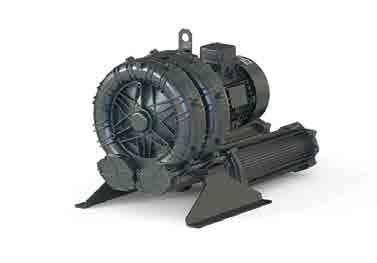
3 minute read
Atlas Copco expands its vacuum range with DB Side Channel Blowers
required. This makes the dry rough vacuum of the DB models suitable for rough industrial processes - such as drying, pneumatic conveying or suction processes. The modular design ensures high efficiency, reliable performance and quiet operation.
Avacuumsolutions, is expanding its comprehensive vacuum pump portfolio with the side channel blowers DB series. Based on an efficient operating principle, the vacuum is created by the kinetic energy of the rotating impeller. The impellers are connected to the motor shaft and enable suction of the pumped medium, which is accelerated in the side channel.
Side channel blowers are designed for applications where high flow rates are

Thanks to the dry, non-contact pumping principle, the exhaust air of the DB vacuum pumps cannot be contaminated; the vacuum is completely free of oil and dust, without any emissions or impurities. The models are equipped as standard with IE3 motors in eco-design and comply with cURus standards. This certification meets all safety requirements for the Canadian and American markets.
Depending on the required vacuum performance, Atlas Copco offers the DB series in single-stage and two-stage versions, optionally with one impeller or twin impellers each. The single-stage version release the pumped
Thelatest research from McKinsey & Company (McKinsey) emphasizes that procurement in construction companies will play a pivotal role as they navigate uncertainty and aim for sustainability targets. The insights come as McKinsey publishes its latest report: The strategic era of procurement in construction.
40 to 70 percent of a construction company’s total spending stems from procurement, and McKinsey’s research reveals that many chief procurement officers (CPOs) in the industry believe that consistent application of best-in-class procurement practices could lead to up to 12 percent cost savings. Despite this, and the significant margin impact, the construction industry is far behind others in implementing these best practices.
The role of Procurement is also rapidly elevating in strategic importance. The construction industry is directly and indirectly impacting 25% of global carbon dioxide emissions mainly through the production processes of the ingoing materials and the energy efficiency of the structure through its lifecycle. As 90% of emissions for construction companies are Scope 3, our report highlights that procurement, as the main interface with the construction value chain, should be in the driver’s seat to reduce the carbon footprint of construction projects and meet corporate sustainability targets.
McKinsey points that Procurement will play a pivotal role in making cost and sustainability trade-offs, identifying the most sustainable suppliers, and securing access to many sustainable materials and technologies that will be in short supply. That requires new skill sets, data and insights, and new decision-making process and involvement in the construction projects by the procurement professionals.
In the near-term, procurement teams of construction companies will need to create transparency and estimations for the CO2 footprint across medium after it has gone through just one stage, while in the two-stage version it enters the second stage after the first one. Operation with twin impellers increases the blower's capacity. The two-stage version 2 (4) achieves a higher vacuum level. The combination of both results in larger air flows and higher vacuum level with just one machine. the value chain, gain granular perspective on costs and emissions from different materials and available suppliers and work with engineering and project management teams to manage trade-offs of cost / value vs emissions to prioritize solutions that can drive both profits and sustainability.
Atlas Copco takes care of maintenance planning and regular servicing of the DB pumps, if required. "Our 'Preventive Care Plan' is tailored exactly to the pump's needs. Since the vacuum pumps are maintained using state-of-the-art technologies, we also achieve a high level of energy efficiency as a result," Carol Pignatelli, the responsible product manager at Atlas Copco, emphasises. Thus, regular maintenance ultimately helps to reduce operating costs and increase process productivity by minimising unplanned downtime.
These actions will be enabled by three key themes:
· Talent and expertise - construction companies will need new expert roles focused on collecting reliable information, guiding, and recommending trade-offs between alternative materials and technologies - tailored to each category and project - assessing design simplifications against impact on value and assessing risks / assessing unproven approaches.
· Roles and mandates – new roles should not only be embedded in the procurement organization but also integrated closely with engineering and design functions and project teams to drive recommendations or alternatives, optimize trade-offs between profitability and sustainability targets, as well as securing access to scarce materials (potentially recommending M&A opportunities).
· Data and market intelligence - procurement teams will need to collect and curate reliable information on the different existing alternatives. This should be built in partnership with suppliers but will require to build own databases, conduct research, and even perform tests when needed. This needs to be complemented with new digital tools, such as dashboards (similar to those used to manage customer relationships) to collect, display, and interpret data.








